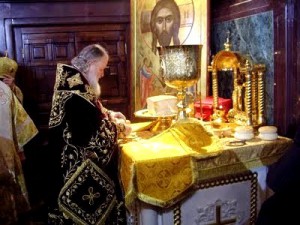
Yesterday, while browsing randomly I came across an interesting Roman Catholic webpage.
The website is created by Catholics with the idea to better explain the Catholic religion and Symbolism.
Though as an Orthodox Christian, my interest towards Roman Catholicism is only scientific, it's really interesting to see the common symbolism surrounding Roman Catholicism and compare with the Orthodox Christian symbolism. Many of the Roman Catholic Symbols are equal symbol with the one we nowadays used in the orthodox church.
I presume this common symbolism between Orthodox and Roman Catholic church,has stayed the same from the time before Roman Catholics split from the Only Holy Apostolic Church to become the Church of the West Roman Empire, that's how the naming Roman Catholic came forward.
To find out more about Roman Catholic symbolism please see the following links I've mirrored the information from Fisheater's website which is btw is a great website targeting Roman Catholic layman. Everything on the website is explained in a simple everyday language without too much terminology which makes it a great resource for Roman Catholic Christians and people like me who who like to take a look in Roman Catholicism.
It's really a strange and intriguing fact let's call it a "co-incidence" that the inverted cross (upside-down) cross,also called "Peter's cross" on which saint Peter was crucified is also a symbol of Papacy .
It's a popular fact that nowadays Satanist use a similar inverted cross to the one said to be symbol of papacy for their "Black Masses" (Satanic Masses). Maybe some Roman Catholic priest or Cardinal has to explain, how comes that the Roman Catholics ended with such a significant symbol used nowdays in anti-christian satanic religion to be also a symbol of their beloved Pope??
I will skip forward to the heart of this article, which is to explain the Christian Symbolism which is important for us the Eastern Orthodox Christians. Many of the symbols might have in common, also with other Christian early Churches like the Coptic Oriental Orthodox Church, the Armenian Apostolic Orthodox Churches and other Chruches which somehow are closer to the One Holy and Apostolic Church – the Orthodox Church but officially are not in communion with us the Orthodox Christians.
Here I'll share only the most notable Christian Symbolism which is also used in the Eastern Orthodox Church.
Many of this symbolism was always bothering me while in Churches or Monasteries and was always pushing me to more and more questions without answers, thus I finally did some research on this symbols in get a better understanding on my Orthodox Christian faith.
Since I don't have a Theologian education and many of us the ordinary layman's in the church doesn't have such education I hope this orthodox Christian symbolism shared here and it's meanings will be of interest and will help you fortify your good faith in God and our Orthodox Christian faith.
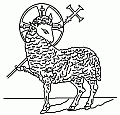
Lamb
Lamb: symbol of Christ as the Paschal Lamb and also a symbol for Christians (as Christ is our Shepherd and Peter was told to feed His sheep).
This symbol is also presented in Bulgaria on the little yellow book they sell in our Bulgarian Orthodox Churches.
This tiny book contains the Divine Liturgy compiled by God's inspiration by st. John Chrysostom
If you're coming from an Catholic Background and you hold interest for Orthodox Christianity, as historically East Orthodox Christianity Symbol of Faith as well as basic doctrines were kept untouched, you might consider reading online here The Divine Liturgy by St. John Chrysostom
It's really important to say that the Divine Liturgy by St. John Chrysostom is the "backbone" of the church life, since it's the main and most served Liturgy in the eastern Orthodox Churches around the world.
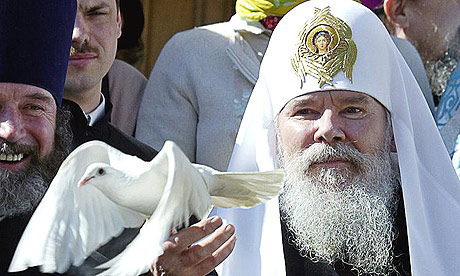
Dove: symbol of the The Holy Spirit and used especially in representations of our Lord's Baptism and the Pentecost. It is also used to recall Noe's dove, a harbinger of hope.
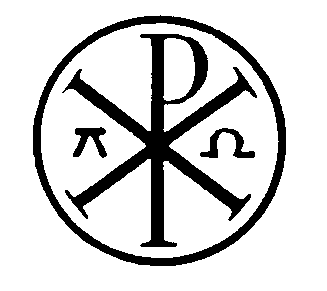
"Chi-Rho" or "sigla": the letters "X" and "P," representing the first letters of the title "Christos," were eventually put together to form this symbol for Christ ("Chi" is pronounced "Kie"). It is this form of the Cross that the Emperor of Byzantia Constantine saw in his vision along with the Greek words, TOUTO NIKA, and which mean "in this sign thou shalt conquer.

"thau" or "tau": the T-shaped cross is mentioned in the Old Testament and is seen as a foreshadowing of the Cross of Christ.
Ezechiel 9:4:
"And the Lord said to him: Go through the midst of the city, through the midst of Jerusalem: and mark Thau upon the foreheads of the men that sigh, and
mourn for all the abominations that are committed in the midst thereof."
I've noticed that the tau_cross is often worn by Orthodox Monks as "a badge" on their clothes somewhere in the right of their chest
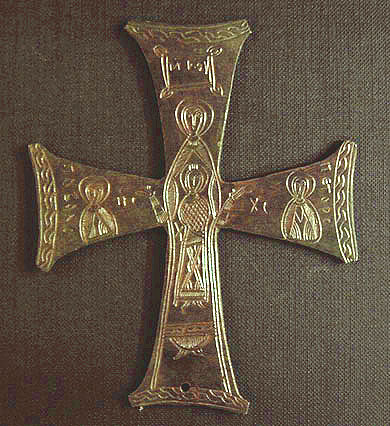
The Greek Orthodox Cross This symbol is one of the earliest Christian symbols which emerged right after Christ's resurrection.
The Greek Cross has all fours members the same shape and form (crux quadrata) and usually suggests the Christian church rather than a symbol of Christ's suffering.

Jerusalem Cross: also called the "Crusaders' Cross," it is made up of 5 Greek Crosses which are said to symbolize a) the 5 Wounds of Christ; and/or b) the 4 Gospels and the 4 corners of the earth (the 4 smaller crosses) and Christ Himself (the large Cross). This Cross was a common symbol used during the wars against Islamic aggression. (see less stylized version at right)

Baptismal Cross: consisting of the Greek Cross with the Greek letter "X", the first initial of the title "Christ," this Cross is a symbol of regeneration, hence, its association with Baptism. Usually the Orthodox priest dress is decorated with a sign like this.

The Scarlet red Egg:
Church tradition has it that St. Mary Magdalen went to Rome and met with the Emperor Tiberius to tell him about the Resurrection of Jesus. She held out an egg to him as a symbol of this, and he scoffed, saying that a man could no more rise from the dead than that egg that she held could turn scarlet. The egg turned deep red in her hands, and this is the origin of Easter eggs, and the reason why Mary Magdalen is often portrayed holding a scarlet egg.

Ichtus (Ichthys) – The Fish:
Fish: the fish — ever-watchful with its unblinking eyes — was one of the most important symbols of Christ to the early Christians. In Greek, the phrase, "Jesus Christ, Son of God Savior," is "Iesous Christos Theou Yios Soter." The first letters of each of these Greek words, when put together, spell "ichthys," the Greek word for "fish" (ICQUS ). This symbol can be seen in the Sacraments Chapel of the Catacombs of St. Callistus. Because of the story of the miracle of the loaves and fishes, the fish symbolized, too, the Eucharist (see stylized fish symbol at right). Important note to make, here is that nowdays this sign's variations is not too often to be seen in Orthodox Churches. It's highly adopted by protestant Christians, seeing this sign on somebody's car or inside his home is a sure sign that probably he adhere's to Christian teachings different from orthodoxy.

The Alpha-Omega symbol
Alpha, the first letter of the Greek alphabet, and Omega, the last letter of the Greek alphabet, became a symbol for Christ due to His being called "the First and the Last." The roots of symbolizing these attributes of God go back further, all the way to the Old Testament where, in Exodus 34:6, God is said to be "full of Goodness and Truth." The Hebrew spelling of the word "Truth" consists of the 3 letters "Aleph," "Mem," and "Thaw" — and because "Aleph" and "Thaw" are the first and last letters of the Hebrew alphabet, the ancients saw mystical relevance in God's being referred to as "Truth." At any rate, the Greek Alpha and Omega as a symbol for Christ has been found in the Catacombs, Christian signet rings, post-Constantine coins, and the frescoes and mosaics of ancient churches.
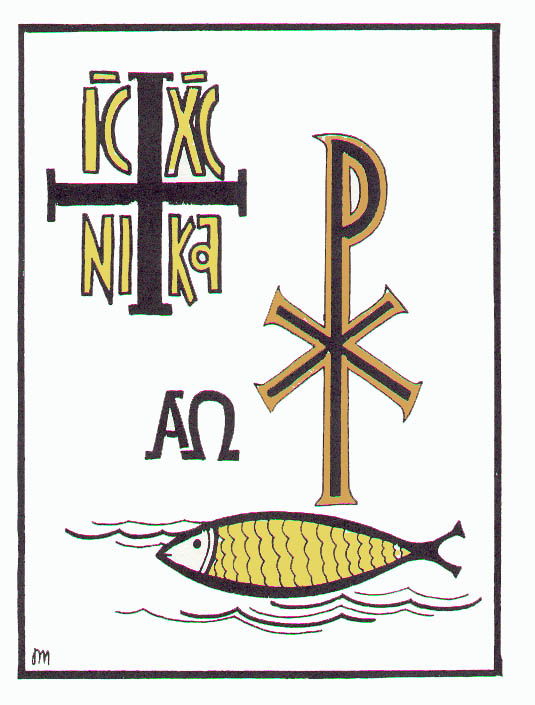
The "IC XC Nika":
comes from Ancient Greek and was a widespread ancient Christian Symbol which is nowadays still present in the Eastern Orthodox Churches. IC XC Nika literally translated to english means "IC XC = Jesus Christ, NIKA = Glory to". In other words translated to modern english IC XC NIKA means Glory be to Jesus Christ!
Many Protestant Christians, nowdays falsely believe and claims this fish Christian symbol preceded the Crucifix as a symbol of veneration of Jesus and his Cross sufferings in the Church. This kind of belief is a falsely spread along many Protestant or "Evangelical" Christian denominations and Methodists. to be seen in many ancient Christian Church buildings is a Christian symbol. Today, some ancient Orthodox Churches still contain the "Christian fish" symbol. The reason why this symbol was used by early Christians is as a remembrance of the great miracle of Jesus to feed 5000 with 2 fishes and seven breads.
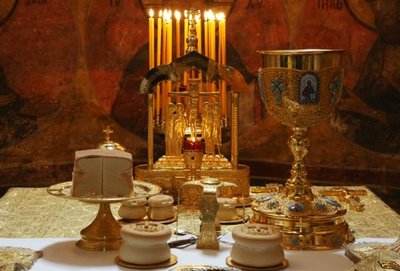
The Holy Eucharist vessels used by Orthodox Priests This is the cup of salvation as also called during the Divine Liturgy each time, the Wine and the Blood that the priest prepares in that Holy Cup is transformed by The Holy Spirit into a veracious flesh and blood of our Lord Jesus Christ.
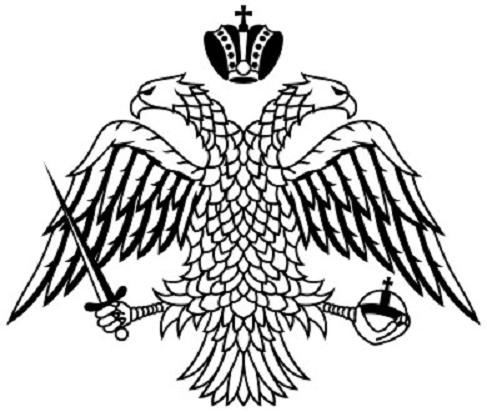
The byzantine coat of arms
is an ancient Christian symbol used in the early Byzantine Church, nowadays it can be observed only in the Orthodox Churches.
It symbolizes the power of the Byzantian empire under the guidance of the the Holy Lord and the Gospel Truths.
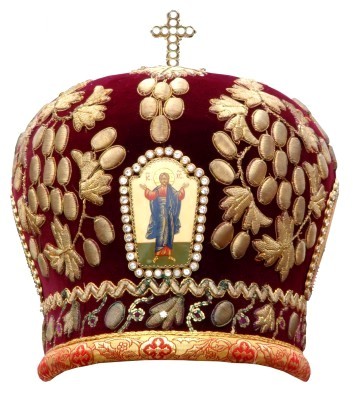
The Orthodox Bishop Crown is only worn by Bishops in the Orthodox Church. This crown indicates the Bishop's Church and spiritual (rank) and dignity.
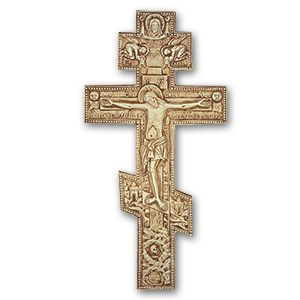
Byzantine Orthodox or Russian Orthodox Cross
Is used most often by Eastern Catholics and Russian Orthodox, this Cross is the Byzantine Cross with the footrest at a diagonal. This slant is said to represent one of a few things:
– the footrest wrenched loose from the Christ's writhing in intense physical suffering; lower side representing "down," the fate of sinners, while the elevated side represents Heaven;
– the lower side represents the bad thief (known to us as Gestas through the apocryphal "Acts of Pilate" ("Gospel of Nicodemus") while the elevated side to Christ's right represents the thief who would be with Him in Paradise (St. Dismas);
– the "X" shape of the slanted "footrest" against the post symbolizes the cross on which St. Andrew was crucified.
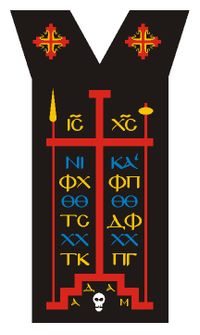
The Megaloschema is a dress worn by schimonks. This monk rank is actually the highest possible rank an orthodox Christian monk can achieve. The symbolism on the dress is a brief form of:
- IC XC (IECOYC XPICTOC) "Jesus Christ"
- IC XC NIKA ("IECOYC XPICTOC NIKA") meaning: "Jesus Christ is Victorious"
The letters below IC XC Nika has a meaning – The Light of Christ shines on all.
- XX. X.X letters. – means "Christ bestows grace on Christians"
- The 4 Thitha (called) signs are a symbol for: Vision of God Divine wonder
Then the
- T. K. P. G – Means "The Place of the Skull becomes Paradise"
- The text placed in the lowest translated to English is "Adam – The First Man" and also is a symbol for the Place of the Skull (Golgotha).
- In the Orthodox Church and the Church fathers teaches us that Golgotha or the Place of the Skull is the Place where the first man (Adam) was buried, and by God's divine providence coincides with the place where our Saviour Jesus Christ was crucified.
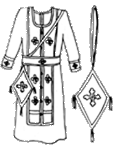
Orthodox Priest dress / robe
This dress is only worn by Orthodox Christian Bishops.
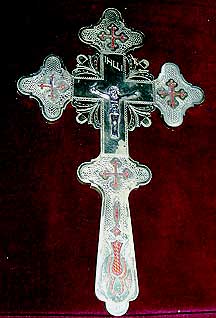
The Cross with four lights emitating near the center of the cross This cross is actually used in more modern times as a Christian Orthodox symbol, The four lights coming out of the cross are added,
as the gospels speak that Christ is the Sun of righteousness
I've had quite a long time trying to figure out why exactly this cross is made with this 4 lights. It was a real joy when one time a priesttold me the meaning.
It's interesting fact that most of the Roman Catholic's crosses nowdays have the four lights radiating from Christ's Crucifix or the Cross symbolizing the Crucifix.
This is all I will say for symbolism for now. I hope this Christian symbolism will shed some light on the matters of Symbolism in both the Orthodox and the Catholoic eastern Church. I'll be glad if somebody out there more literate on the subject comment on my post and correct me if I'm wrong with smething.
More helpful Articles

Tags: Baptism, bishop, black masses, Catholic, catholic layman, catholic religion, catholic symbols, Chi, christian symbolism, church symbolism, church symbols, city, common, Cross, divine, Divine Liturgy, Dove, dress, East, eastern orthodox church, egg, Egg Church, fish, holy apostolic church, interest, interesting fact, intriguing fact, inverted cross, Kie, long time, midst, nbsp, nowdays, Old, orthodox christian faith, orthodox christians, orthodox priests, Pentecost, priest, questions without answers, quot, reason, resurrection, right, righteousness, roman catholic christians, roman catholic church, roman catholic priest, roman catholicism, roman catholics, roman empire, Russian, saint peter, side, sign, Some of the most important Symbols for Orthodox Christians in The Eastern Orthodox Church - Symbols in the Eastern Orthodox Christian Faith (Eastern Orthodox Symbolism) and Christian Symbolism in the , Spirit, suffering, symbol, Thaw, theone, website, western catholicism








Opera/9.64(Windows NT 5.1; U; en) Presto/2.1.1
Hearing this current kidnap danger in Sinai, I really hope that the visitors especially Israeli citizens are secure and keeping safe.
View CommentView CommentMozilla/4.0 (compatible; MSIE 7.0; Windows NT 5.1; .NET CLR 1.1.4322; .NET CLR 2.0.50727; .NET CLR 3.0.04506.30)
I’m grateful for you because of this good articles. You definitely did make my day :
View CommentView CommentMozilla/4.0 (compatible; MSIE 6.0; Windows NT 5.1; en) Opera 8.50
This domain appears to get a good ammount of visitors. How do you promote it? It gives a nice individual spin on things. I guess having something real or substantial to talk about is the most important factor.
View CommentView CommentMozilla/5.0 (Windows; U; Windows NT 5.1; pl; rv:1.9.1.3) Gecko/20090824 Firefox/3.5.3
Congratulations It was an excellent piece of writing. Perform continue when you are. We shall be excitedly waiting.
View CommentView CommentOpera/9.64(Windows NT 5.1; U; en) Presto/2.1.1
Extremely nice posting. I just bookmark your blog and would like to say that I have certainly appreciated while reading through your content. Thank you for sharing the information with all.
View CommentView CommentMozilla/5.0 (Windows; U; Windows NT 5.1; en-US; rv:1.9.2.3) Gecko/20100401 Firefox/3.6.3
Thank you so much for this enlightening piece of work. it is a very helpful site and i wish many people knew of its existence.
View CommentView CommentMay God bless the work of your hands and reward you.
Mozilla/5.0 (X11; U; Linux x86_64; en-us) AppleWebKit/531.2+ (KHTML, like Gecko) Version/5.0 Safari/531.2+ Debian/squeeze (2.30.6-1) Epiphany/2.30.6
Thank you father!
View CommentView CommentMozilla/5.0 (Windows; U; Windows NT 6.1; en-US) AppleWebKit/534.16 (KHTML, like Gecko) Chrome/10.0.648.204 Safari/534.16
Nice post! So many interesting things that I had just read on your blog. I like the other links to so fascinating. Keep it up!
Well done 🙂
-Charle
View CommentView Commentv
Mozilla/4.0 (compatible; MSIE 8.0; Windows NT 6.0; Trident/4.0; GTB7.0; SLCC1; .NET CLR 2.0.50727; Media Center PC 5.0; .NET CLR 3.5.30729; .NET4.0C; .NET CLR 3.0.30729)
GOD’s Signet is revealed in light of the boustrophedonical number 2701 which is the triangle number of the 21st prime number (73). Enjoy.
View CommentView CommentMozilla/5.0 (Windows NT 5.1; rv:6.0.1) Gecko/20100101 Firefox/6.0.1
Very interesting, could you please write what the symbols represent in original (not in translation) right after NI KA? Thank you.
View CommentView CommentMozilla/5.0 (X11; U; Linux i686; en-US; rv:1.9.2.17) Gecko/20110422 Ubuntu/8.04 (hardy) Firefox/3.6.17
As far as I know the word “NIKA” is the Greek word for “conquers” or the verb for “victory”, a possibility is “is is victorious. NI KA is also stamped on prophora in the holy altar.
‘IC XC NI KA’ is meaning: “Jesus Christ is victorious” (i.e., over death and sin).
I’m not sure if this answers your question, I’m not sure the exact meaning of NI and KA in greek but I think actually it’s not two separate words. But just a way to write it down.
best!
View CommentView CommentGeorgi
Mozilla/5.0 (Windows NT 5.1; rv:6.0.1) Gecko/20100101 Firefox/6.0.1
Thank you, this was really fast answer. I was actually curious about the next letters. Fi X Fi P and the rest of the lines which you were so kind to give them in translation I would like to know what they stand for in Greek (probably). I tried to google them but I got only gibberish.
View CommentView CommentAgain, thank you, very interesting information.
Mozilla/5.0 (X11; U; Linux i686; en-US; rv:1.9.2.17) Gecko/20110422 Ubuntu/8.04 (hardy) Firefox/3.6.17
Do you mean the Chi-Rho sign. The XP there stands for ХриÑÑ‚Ð¾Ñ meaning (Christ) in Church slavonic.
View CommentView CommentMozilla/5.0 (Macintosh; Intel Mac OS X 10_7_2) AppleWebKit/534.52.7 (KHTML, like Gecko) Version/5.1.2 Safari/534.52.7
It will be easier for everyone to understand if you refer to the letters as cyrillic instead of church slavonic. The cyrillic X is actually the letter “H” in English, and the P is actually the letter “R” in English. And Christ is pronounced Hree-stos, hence the abbreviated spelling of the name. So really, XP just means HR (if you translate the cyrillic letters into the English latin alphabet).
View CommentView CommentMozilla/5.0 (X11; U; Linux x86_64; en-us) AppleWebKit/531.2+ (KHTML, like Gecko) Version/5.0 Safari/531.2+ Debian/squeeze (2.30.6-1) Epiphany/2.30.6
thx for the advice.
best!
View CommentView CommentGeorgi
Mozilla/5.0 (X11; U; Linux i686; en-US; rv:1.9.2.10) Gecko/20100922 Ubuntu/10.10 (maverick) Firefox/3.6.10
Warm greetings in name of Jesus Christ
View CommentView Comment1
After visiting your web I have been so much impressed
wish you all the best
with Love in Christ
Peter
Mozilla/5.0 (X11; Linux i686) AppleWebKit/535.2 (KHTML, like Gecko) Ubuntu/10.04 Chromium/15.0.874.106 Chrome/15.0.874.106 Safari/535.2
Thanks a bunch brother.
Let our Lord Jesus Christ give you grace abundantly also!
Best
View CommentView CommentGeorgi
Mozilla/5.0 (Windows NT 6.1; WOW64; rv:11.0) Gecko/20100101 Firefox/11.0
Dobry Den,
Good introduction. I was especially impressed with the “Tau” cross in its connection with Ezekiel.
I don’t know, but I suspect the “Tau” is more likely a Hebrew “Tav”, in the original alphabet, than a Greek “Tau”. The current Hebrew alphabet is borrowed from Aramaic. The original Hebrew looks very much like Phonecian. From there and the connection with Deuteronomy 4:8, the “Tav” would be “Torah” = Law/custom. Thus, a symbol of the Law on their foreheads.
Also just a small correction. The small picture of the “Bishop’s” vestments (2nd to bottom) is actually for a Priest, not a Bishop.
Love in Christ
View CommentView CommentMozilla/5.0 (X11; U; Linux x86_64; en-us) AppleWebKit/531.2+ (KHTML, like Gecko) Version/5.0 Safari/531.2+ Debian/squeeze (2.30.6-1) Epiphany/2.30.6
Добър Ден John,
Thanks for pointing for the small mistake I made in the article about the dress it is now fixed. Also I didn’t know the connection of Tav to Deuteronomy.
Love in Christ,
View CommentView CommentGeorgi
hip0 recently posted…Home
Mozilla/5.0 (Windows NT 6.1; WOW64) AppleWebKit/535.19 (KHTML, like Gecko) Chrome/18.0.1025.162 Safari/535.19
On the megaloschema you have made a slight mistake in calling the four thitas omegas, but otherwise a great and accurate article
View CommentView CommentMozilla/5.0 (X11; U; Linux x86_64; bg-bg) AppleWebKit/531.2+ (KHTML, like Gecko) Version/5.0 Safari/531.2+ Debian/squeeze (2.30.6-1) Epiphany/2.30.6
Thanks, brother I have corrected the omega mistace in the article. Pray for me the sinner …
View CommentView CommentMozilla/5.0 (Windows NT 6.1; WOW64) AppleWebKit/535.19 (KHTML, like Gecko) Chrome/18.0.1025.162 Safari/535.19
For you and the whole world.
View CommentView CommentMozilla/4.0 (compatible; MSIE 7.0; Windows NT 5.1; .NET CLR 1.1.4322; .NET CLR 2.0.50727; .NET CLR 3.0.04506.30)
Hi all – I have a straight-up HTML website that I’d like to transition to Joomla. If possible, I’d like to install Joomla into a subfolder and create and test the site there, while keeping the existing site functioning until I’m ready to move it over. Is this possible?. . Thanks!.
View CommentView CommentMozilla/5.0 (compatible; MSIE 9.0; Windows NT 6.1; WOW64; Trident/5.0; NP06)
Hello & God bless everyone,
View CommentView CommentI enjoyed the article & it was interesting & mostly informative. There's just one thing – I don't think it's fair to spread misinformation (even though I believe it's unintentional): Implying or stating that the Christian Orthodox church was "first" is just incorrect & unnessecary. I think the writer of the above article may only be confused or has been misinformed. The Orthodox Christian church, Armenian Christians etc. are no older than the Roman "Catholic" = Universal church. Christianity began w/ Jesus & His teaching & that's when ALL of these regional groups of Catholics/Christians began. The following explains this & you & your readers may find it very interesting.
The Catholic and Orthodox Churches are equally old. Prior to the Great Schism of 1054 AD, they formed the same universal church, which they variously called Catholic (universal) and orthodox, but which modern scholars often call the Catholic-Orthodox Church.
In 1054, Pope Leo IX and Patriarch Michael I excommunicated each other, bringing about a schism in the Church. The Western Church became known as the Roman Catholic Church, while the eastern Churches became known as Orthodox. There were attempts at reconciliation and the two sides came close to being reunited in 1274 and in 1439, but the schism eventually became permanent.
The church, recognized in the bible as "the church" was already in existence since it was started by Jesus himself. Paul mentions this fact numerous times. The word Catholic, from the greek translation, means "Universal" and was used to describe the church in writings as early as 46AD. The Term Roman Catholic is simply a westerners term used to describe the fact that Catholics look to Rome as the head of the church. There is nothing in writing or from the Vatican that names the Catholic church "Roman Catholic. The bible was not even produced until the first Nicaean Council in 325AD. But by then, the Catholic/Christian church was well established and growing throughout the world.
We are all children of God from the same inital faith, ther is no point in trying to claim "who was first" because the truth is no one was first, they all were formed when Christ began His ministry.
Sincerely,
your friend & brother in Christ
Derek
Mozilla/5.0 (Macintosh; Intel Mac OS X 10.6; rv:21.0) Gecko/20100101 Firefox/21.0
Useful info. Lucky me I found your site by accident, and I’m surprised why this twist
View CommentView Commentof fate didn’t took place in advance! I bookmarked it.
Mozilla/5.0 (Windows NT 6.1; WOW64; rv:42.0) Gecko/20100101 Firefox/42.0
Dear Sir,
My friend here in the USA has a small cross about 3inches long dated 900 AD.
He would like to know where it is coming from. It might be from Eastern Orthodox Christianity so I thought you might be able to identify it.
I would like to send you pictures.
This is my e mail address: abenalon@gmail.com
Thank you
View CommentView CommentAmnon
Mozilla/5.0 (Macintosh; Intel Mac OS X 10_10_1) AppleWebKit/537.36 (KHTML, like Gecko) Chrome/39.0.2171.99 Safari/537.36
Tɦanks for sharing your thoughts оn baptism. Regards
View CommentView CommentMozilla/5.0 (Windows Phone 8.1; ARM; Trident/7.0; Touch; rv:11.0; IEMobile/11.0; NOKIA; Lumia 630) like Gecko
WHAT SYMBOL IS A VIFE POINTED STAR COMBINED WITH THE ALL SEEING EYE WITH VIFE RAYS BENEATH ?
View CommentView CommentMozilla/5.0 (X11; Linux x86_64) AppleWebKit/537.36 (KHTML, like Gecko) Chrome/79.0.3945.88 Safari/537.36
test
View CommentView Comment